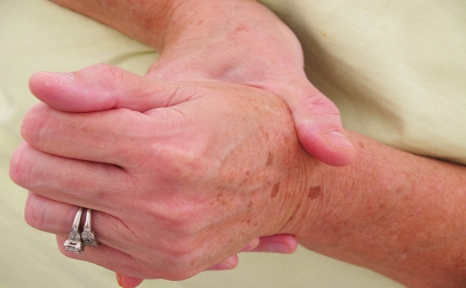


If you have rheumatoid arthritis, you probably already know you are at greater risk for osteoporosis, a medical condition where bones become brittle and fragile from loss of tissue.
But there is a silver lining: Osteoporosis prevention is possible. So, while you can’t cure yourself of arthritis or its associated risks, you can take precautions to guard against bone disease.
Osteoporosis is typically a result of hormonal changes, or deficiency of calcium or vitamin D. But studies have also found an increased risk of bone loss and fracture in individuals with rheumatoid arthritis.
Several factors contribute to this increased risk. First, glucocorticoid medications – often prescribed for the treatment of rheumatoid arthritis – can cause significant bone loss. Second, a person may be inactive because of pain and lost function caused by the arthritis, further adding to their osteoporosis risk. Studies also show bone loss in rheumatoid arthritis may be a direct result of the disease, especially in areas immediately surrounding the affected joints.
The prevalence of osteoporosis and low bone mass is expected to increase as the population ages. Currently, it affects 10 million people – 8 million of whom are women – and another 34 million adults are at risk, according to the Arthritis Foundation. The Surgeon General has warned these numbers may climb to half of all Americans older than 50 being at risk by 2020.
Fractures are by far the biggest problem caused by bone disease. About 1.5 million people suffer an osteoporosis-related bone fracture each year, making this a common, costly and sometimes debilitating problem.
So, what can you do to keep your bones strong and healthy? Here are some tips for avoiding osteoporosis.
As someone with rheumatoid arthritis, you are already at greater risk. Knowing other risk factors can help you assess how great that risk may be.
Osteoporosis has no symptoms. People often don’t realize they have it until they’ve fractured a bone. Your doctor can do a bone density test – the only definitive way to diagnose the condition. He or she may also do a physical exam including reviewing your history; measuring to see if you’re getting shorter; and, checking the spine for curvature.
Bone density tests are recommended for women over the age of 65 and everyone over the age of 50 who has suffered even a minor fracture. You may want to ask your doctor about testing even earlier, depending on your risk. If diagnosed in time, osteoporosis can be fought with lifestyle changes and medication.
Regular exercise can help prevent bone loss. Bonus: It’s also good for your arthritis. The best activity for bones are weight-bearing exercises, but since those might be especially hard for someone with arthritis, it’s important to note even walking is helpful. Exercise can also help you maintain a healthy weight, which will help arthritis and discourage osteoporosis.
Calcium and vitamin D are important for healthy bones. Up to age 50, it’s recommended you have a daily calcium intake of 1,000 mg. If you’re over age 50, shoot for 1,200 mg of calcium a day. The goal for vitamin D intake should be 600 to 800 international units per day. You may want to take a supplement for each if you aren’t able to reach these goals on your own.
Share your tips for preventing osteoporosis in this discussion thread.
Copyright © www.orthopaedics.win Bone Health All Rights Reserved